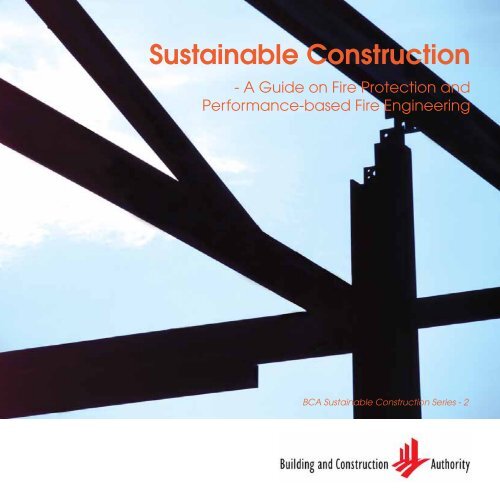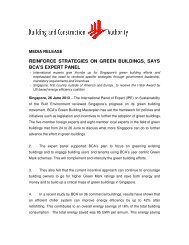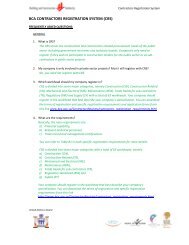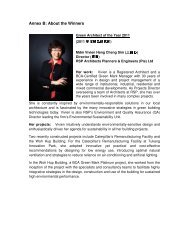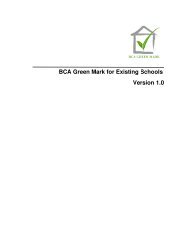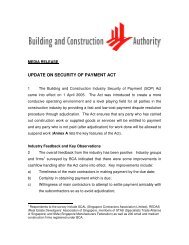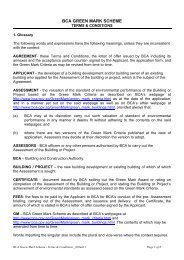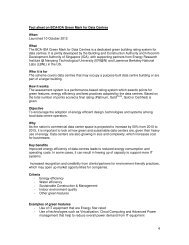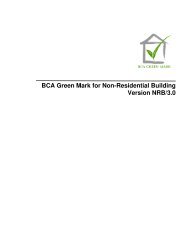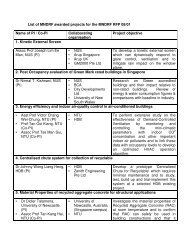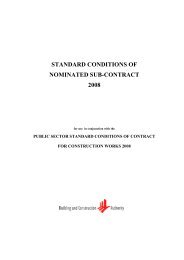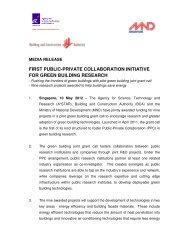Sustainable Construction - Building & Construction Authority
Sustainable Construction - Building & Construction Authority
Sustainable Construction - Building & Construction Authority
You also want an ePaper? Increase the reach of your titles
YUMPU automatically turns print PDFs into web optimized ePapers that Google loves.
<strong>Sustainable</strong> <strong>Construction</strong><br />
- A Guide on Fire Protection and<br />
Performance-based Fire Engineering<br />
BCA <strong>Sustainable</strong> <strong>Construction</strong> Series - 2
<strong>Sustainable</strong> <strong>Construction</strong><br />
- A Guide on Fire Protection and<br />
Performance-based Fire Engineering
<strong>Sustainable</strong> <strong>Construction</strong> -<br />
2
Foreword<br />
A Guide Fire on Protection Fire Protection and Performance-based and Performance-based Fire Engineering Fire Engineering<br />
The <strong>Building</strong> and <strong>Construction</strong> <strong>Authority</strong> (BCA) has been working closely<br />
with industry partners to promote sustainable construction. <strong>Sustainable</strong><br />
construction refers to the adoption of building designs, construction<br />
methods and materials that are environmentally friendly. It also means<br />
using materials and resources that have sustainable supplies and are<br />
readily available from many sources.<br />
Instead of relying too heavily on raw materials such as sand and<br />
granite, we should also consider the adoption of steel, composite<br />
materials and other forms of construction such as using drywalls.<br />
However one major concern among the building practitioners is the<br />
level of fire protection required and the effectiveness of these<br />
protective measures. It is therefore important to address these issues<br />
and clear the misperceptions that are associated with fire protection<br />
for sustainable construction. This publication is timely as the Fire<br />
Code had been reviewed and the revised Fire Code was published<br />
in June 2007 to address these concerns.<br />
This is the second in the <strong>Sustainable</strong> <strong>Construction</strong> series. It aims to provide<br />
information on fire safety requirements for buildings adopting steel and<br />
other methods of sustainable construction, different passive fire protection<br />
methods and the concept of performance-based fire engineering.<br />
Special thanks go to the Working Committee members for their time and<br />
effort in preparing this publication. I am confident that it will promote a<br />
better understanding of fi re safety requirements for sustainable construction<br />
and serve as a useful guide for all building practitioners.<br />
Dr John Keung<br />
Chief Executive Offi cer<br />
<strong>Building</strong> and <strong>Construction</strong> <strong>Authority</strong><br />
3
<strong>Sustainable</strong> <strong>Construction</strong> -<br />
4
Content<br />
A Guide Fire on Protection Fire Protection and Performance-based and Performance-based Fire Engineering Fire Engineering<br />
06 Introduction<br />
07 Terminology simply explained<br />
08 Using the Guide<br />
11 Section 1: General Requirements<br />
25 Section 2: <strong>Building</strong> Elements<br />
39 Section 3: Fire Protection Methods<br />
63 Section 4: Performance-based Approach to<br />
Fire Safety Design<br />
76 References<br />
77 Acknowledgements<br />
78 Photographs/Graphics Credit<br />
5
Introduction<br />
<strong>Sustainable</strong> <strong>Construction</strong> -<br />
The <strong>Building</strong> and <strong>Construction</strong> <strong>Authority</strong> has been actively promoting<br />
sustainable construction to the construction industry. Various efforts have<br />
been put in place to encourage wider use of sustainable materials and<br />
products such as steel, drywalls and recycled materials.<br />
One major concern on the use of sustainable construction is the level of fi re<br />
protection required and the effectiveness of these protective measures.<br />
Traditionally, designers follow a set of prescriptive Fire Code requirements<br />
in applying the required fi re protection. However, in recent years, performancebased<br />
fire safety engineering has gained popularity among designers,<br />
especially for big and complex buildings as more economic designs can<br />
be obtained through analysis and modeling.<br />
This Guide attempts to provide useful information on passive fi re protection<br />
and fire engineering for building practitioners who are involved in the<br />
development, design and construction of buildings using sustainable<br />
materials. It comprises four sections. Section One explains the general<br />
requirements pertaining to fire resistance. Section Two elaborates the<br />
application of metal decking system, drywall system, fi re-rated ceiling board<br />
system and other dry construction. Section Three highlights the different<br />
types of passive fire protection and Section Four explains the concept of<br />
performance-based fi re engineering.<br />
Detailed engineering analysis and/or calculations and active fi re protection<br />
measures such as sprinkler system and mechanical ventilation are beyond<br />
the scope of this Guide. Designers are advised to refer to technical journals<br />
for comprehensive design and analysis.<br />
6
A Guide Fire on Protection Fire Protection and Performance-based and Performance-based Fire Engineering Fire Engineering<br />
Terminology simply explained<br />
Combustible<br />
Compartment<br />
Compartment wall/<br />
compartment floor<br />
Cubical extent<br />
Fire engineering/<br />
Fire safety<br />
engineering<br />
Fire protection<br />
Fire resistance/<br />
Fire rating<br />
Flammable<br />
Relevant <strong>Authority</strong><br />
Material that burns intensely, or has rapid rate of flame<br />
spread.<br />
A part of a building separated from all other parts<br />
of the same building by compartment walls and/or<br />
compartment floors. A roof space above the top storey of<br />
a compartment is included in that compartment.<br />
A wall or a floor which is provided for the purpose of<br />
dividing a building into compartments.<br />
The cubicle extent of a building or compartment is<br />
the volume of space contained within the building<br />
or compartment.<br />
A branch of engineering discipline that deals with the<br />
application of science and engineering principles<br />
to protect people and their environments from the<br />
destructive effects of fire and smoke.<br />
Prevention and reduction of the hazards associated with<br />
outbreak of fire.<br />
The minimum period of time during which an isolated<br />
structural or non-structural element may be expected to<br />
function satisfactorily while subjected to a standard fire<br />
test. The standard fire test referred to by the Fire Code is<br />
the British Standards BS 476 Part 20 to 23 or its equivalent.<br />
Material quality that could ignite easily when exposed<br />
to flame.<br />
Relevant <strong>Authority</strong> means the Commissioner of Singapore<br />
Civil Defence Force and includes officers authorised<br />
by him generally or specifically to exercise the powers,<br />
functions and duties conferred by the Fire Safety Act.<br />
7
Using the Guide<br />
<strong>Sustainable</strong> <strong>Construction</strong> -<br />
This Guide is divided into 4 sections. Information pertaining to frequently asked questions are listed<br />
here for easy reference.<br />
SECTION 1: General Requirements Page<br />
• What are some of the revisions made to the Fire Code? 12<br />
• Are fi re safety requirements more stringent for steel buildings than concrete building? 13<br />
• How to verify that a fi re protection system or material has passed the fi re resistance<br />
test?<br />
14<br />
• Must compartment walls be constructed using concrete or masonry? 16<br />
• Can bare steel structures be used for standalone carpark construction? 20<br />
• What is the minimum requirement of fi re resistance for single-storey buildings? 21<br />
• Is submission of fi re safety plan to the Relevant <strong>Authority</strong> required for a landed house? 22<br />
• What is the fi re resistance requirement for fully automated mechanised car park? 23<br />
• Do steel-framed buildings require more building inspections for fire protection<br />
systems?<br />
24<br />
SECTION 2: <strong>Building</strong> Elements Page<br />
• Is fi re protection required for composite metal decking fl oor system? 27<br />
• Is there any other alternative dry construction for fl oor systems? 29<br />
• Can drywall systems be used as party walls? 30<br />
• Are combustible materials allowed to be used in external walls? 33<br />
• Can drywalls be used to construct protected shafts? 36<br />
• Are services allowed within the ceiling space if a fi re-rated ceiling board system is<br />
used to protect bare steel structures?<br />
37<br />
• Is fi re protection required for metal roofs? 38<br />
8
SECTION 3: Fire Protection Methods Page<br />
• What are the available methods to fi re protect steel-framed buildings? 40-60<br />
• Is modifi cation to a proprietary fi re protection system allowed? 42<br />
• What are the ways to achieve a cost-effective fi re protection system? 62<br />
Fire-rated boards<br />
• Do the fi re-rated boards need to be in full contact with the steel element? 43<br />
• Are fi re-rated boards suitable for circular steel members? 44<br />
• Is there any restriction to the use of fi re-rated board systems? 45<br />
• What are the good practices on storing and handling of fi re-rated boards? 46<br />
• Are fi re-rated boards allowed at wet areas? 47<br />
Cementitious spray-fi reproofi ng<br />
• Can cementitious spray-fi reproofi ng be used for all steel sections? 49<br />
• What are the surface preparation works needed to receive the spray- fi reproofi ng? 50,53<br />
• What are the do’s and don’ts when applying the spray-fi reproofi ng? 51,52<br />
• How can the surface appearance of the spray-fi reproofi ng be improved? 53<br />
Intumescent paint<br />
A Guide on Fire Protection and Performance-based Fire Engineering<br />
• How does intumescent paint work? 54<br />
• Do bigger steel sections require a thicker coat of intumescent paint? 55<br />
• Can intumescent paint be applied to external areas? 56<br />
• Is there any restriction to the use of intumescent paint? 57<br />
• What are the surface preparation works needed to receive the intumescent paint? 58<br />
• How to verify the thickness of intumescent paint? 60<br />
9
Abbreviations<br />
<strong>Sustainable</strong> <strong>Construction</strong> -<br />
SECTION 4: Performance-based Approach to Fire Safety Design Page<br />
• What is performance-based fi re engineering? 64<br />
• What is the rationale of allowing developers/Qualifi ed Persons to choose the type of<br />
approach (i.e. prescriptive or performance-based) to fi re safety design?<br />
65<br />
• Is performance-based approach less stringent than prescriptive approach? 66<br />
• When should performance-based approach be adopted? 68<br />
• When are the Fire Safety Engineer (FSE) and Peer Reviewer required? 69<br />
• Is it mandatory to engage a Registered Inspector (RI) who is an FSE for performancebased<br />
fi re safety works?<br />
• Is it necessary to engage an FSE to re-evaluate addition and alteration works? 70<br />
• Can a building be entirely designed to performance-based solutions? 71<br />
The following abbreviations will be used in this publication:<br />
ASTM American Society for Testing and Materials<br />
BS British Standard<br />
Cl. Clause<br />
COC Certificate of Conformity<br />
CP Code of Practice<br />
DOC Declaration of Compliance<br />
EC European Code<br />
Fire Code Code of Practice for Fire Precautions in <strong>Building</strong>s 2007<br />
ISO International Organisation for Standardisation<br />
PLS Product Listing Scheme<br />
PSB Tüv Süd PSB Pte Ltd<br />
QP Qualified Person<br />
SS Singapore Standard<br />
10<br />
70
A Guide on Fire Protection and Performance-based Fire Engineering<br />
11<br />
Section 1:<br />
General Requirements
<strong>Sustainable</strong> <strong>Construction</strong> -<br />
One of the main provisions of the Fire Code requires building elements and building materials<br />
to achieve the appropriate fire resistance when they formed part of the building compartment.<br />
The structural elements of a building are to be constructed with non-flammable or noncombustible<br />
materials and with the desired rating in fire resistance.<br />
In considering the types of structural materials to be used in a new<br />
building, one must know that the minimum period of fire resistance<br />
depends on factors such as the usage, floor area, habitable height<br />
and cubicle extent of the building. The required fire resistance does<br />
not depend on the type of building materials used in the building.<br />
Materials such as rubber and wood are combustible.<br />
What are some of the revisions made to the Fire Code?<br />
One of the major changes to the 2007 revision is the relaxation on the use of fi re-rated boards and<br />
intumescent paint on structural steel beams and columns. In the earlier version, such methods<br />
are allowed for the protection of structural steel beams and columns, provided the building<br />
does not exceed 24m in height. For buildings exceeding 24m in height, they are allowed to be<br />
used only on beams (excluding transfer beams).<br />
In the 2007 revision, fired-rated boards and intumescent paint can be used to protect structural<br />
steel columns and beams in all types of buildings with no height restriction imposed. However,<br />
in areas that are likely to subject to the risks of explosion or where there is presence of corrosive<br />
atmosphere, the QP should consult the Relevant <strong>Authority</strong>.<br />
12
A Guide Fire on Protection Fire Protection and Performance-based and Performance-based Fire Engineering Fire Engineering<br />
Are fire-safety requirements more stringent for steel buildings than concrete<br />
buildings?<br />
The fi re-safety requirements are similar for both types of buildings. The only difference is the method<br />
of protection which depends on whether the building is constructed using steel or concrete.<br />
Fire resistance is a property of a particular building element which measures its ability to resist the<br />
spread of fire through the material characteristics of<br />
• stability (resistance to collapse or excessive deflection);<br />
• integrity (resistance to passage of flames and hot gases); and<br />
• insulation (resistance to excessive temperature rise on exposed face).<br />
Usually, fi re resistance of a building element is expressed in terms of the minimum period of time<br />
during which the building element would function satisfactorily while subject to a standard fi re test,<br />
measured in BS 476: part 20 to 23.<br />
It is the onus of the designer to accord additional and appropriate level of fi re protection to materials<br />
used in the building which do not meet the required rating of fi re resistance.<br />
13
<strong>Sustainable</strong> <strong>Construction</strong> -<br />
How to verify that a fire protection system or material has passed the fire<br />
resistance test?<br />
All testing of non-combustible materials and fire-rated construction have to be certified under<br />
the Product Listing Scheme (PLS) managed by an Accreditation Body. Currently in Singapore, the<br />
PLS is managed by Tüv Süd PSB Pte Ltd (formerly known as PSB Corporation).<br />
Any building material/system that is intended for fi re safety works listed under<br />
the PLS and used in compliance with the requirements stipulated in the Fire<br />
Code, would be deemed to be acceptable to the Relevant <strong>Authority</strong>.<br />
No separate approval is required. The said scheme took effect from 1 April<br />
1998. The following URL provides more information about the PLS:<br />
http://www.tuv-sud-psb.sg/testing/prodcert_prodlist.shtml<br />
These listed fi re-rated building materials/systems are usually<br />
proprietary systems that have undergone vigorous fi re tests to<br />
ensure that they are able to function satisfactorily in events<br />
of a real fi re. Some examples are fi red-rated partition system<br />
and fi re- rated ceiling board system.<br />
A partition system would consist of the steel stud frames<br />
with plaster (or gypsum) boards of certain thickness and<br />
sound insulation material (such as rockwool). A fire-rated<br />
ceiling board system would consist of the ceiling board<br />
hangers, the ceiling board and sound insulation material.<br />
Therefore, anyone who intends to use a fire-rated material/<br />
system should check with the manufacturers to ensure that<br />
the complete system is adopted.<br />
14
ABC Company<br />
123 XYZ Road<br />
Singapore 999999<br />
A Guide Fire on Protection Fire Protection and Performance-based and Performance-based Fire Engineering Fire Engineering<br />
SAMPLE<br />
The Declaration of Compliance (DOC) is a projectbased<br />
document that is given to each individual<br />
project after the application of the listed product.<br />
For instance, after the application of intumescent<br />
paint onto a building, the manufacturer/applicator will<br />
apply to PSB for a DOC.<br />
Products listed in the PLS will be granted a<br />
Certifi cate of Conformity (COC) by PSB. This is<br />
a product-based certificate that is given to<br />
each individual product. For instance, a supplier<br />
who has 3 types of products listed in the PLS will<br />
have 3 COCs.<br />
15<br />
SAMPLE
Compartment walls and fl oors<br />
<strong>Sustainable</strong> <strong>Construction</strong> -<br />
Must compartment walls be constructed using concrete or masonry?<br />
A compartment is a part of a building separated from other parts of the same building by<br />
compartment walls, floors and other relevant separating structures.<br />
The purpose of dividing a building into compartments is to prevent the spread of fire between<br />
specified parts of a building. This is the most basic passive protection device to limit the fire<br />
size, contain the fire and prevent the spread of<br />
fire and smoke from one part of the building<br />
to another. Therefore compartment walls and<br />
floors have to be in non-combustible materials<br />
to achieve the desired fire resistance rating.<br />
Compartment walls and floors form part of<br />
elements of structure which include beams,<br />
columns, loadbearing walls and external walls.<br />
The desired fire resistance of compartment wall,<br />
floor and other relevant separating structures is<br />
the minimum period of time during which a<br />
particular building element may be expected to<br />
function satisfactorily while subject to a standard<br />
fire test, currently measured in BS 476: Part 20<br />
to 23.<br />
The same compartment rules apply to both concrete and steel-framed buildings.<br />
It is not necessary for compartment walls to be in concrete or masonry construction.<br />
Drywalls that comply with the performance criteria stipulated in the Fire Code can<br />
also be used as compartment walls.<br />
16
A Guide Fire on Protection Fire Protection and Performance-based and Performance-based Fire Engineering Fire Engineering<br />
Compartmentation requirements for different types of buildings<br />
For residential buildings, compartment walls and fl oors have to be provided to separate a residential<br />
unit or maisonette from any other parts of the same building.<br />
Residential<br />
Unit<br />
Residential<br />
Unit<br />
Production Area<br />
Compartment<br />
f Walls & Floors g<br />
Residential<br />
Unit<br />
Office<br />
Compartment<br />
Walls<br />
Residential<br />
Unit<br />
Store<br />
Each residential unit has to be compartmented with a<br />
minimum one-hour fire resistance. However, higher fire<br />
resistance ratings prevail:<br />
• if the wall forms part of the protected shaft which<br />
requires more than one-hour fire resistance,<br />
OR<br />
Compartments of different<br />
purpose groups<br />
• if the wall separates the residential section from<br />
the section of another purpose group that requires<br />
more than one-hour fire resistance.<br />
For a building that houses different purpose<br />
groups within the same building, provision of<br />
compartmentation is required because of the<br />
dissimilar risk of the rooms and spaces.<br />
If it is necessary to provide doors at the compartment<br />
wall, the doors are required to have the same fi re<br />
rating as the walls, unless otherwise stated and<br />
permitted under the Fire Code.<br />
17
1 Hour Fire-Rated Walls<br />
<strong>Sustainable</strong> <strong>Construction</strong> -<br />
Compartment<br />
Walls<br />
f g<br />
Hotel<br />
Bedrooms<br />
For hotels, each hotel bedroom is to be enclosed with one-hour fire resistant construction. This<br />
requirement is to protect against fire and smoke spreading into sleeping quarters and the risk of fire<br />
starting within the privacy of bedrooms and spreading to other parts of the building.<br />
As internal corridors are requisite means of escape, the internal corridor has to be compartmented<br />
from hotel bedrooms with one-hour fire rated compartment walls and half-hour fi re doors.<br />
18<br />
Half Hour Fire Doors
A Guide Fire on Protection Fire Protection and Performance-based and Performance-based Fire Engineering Fire Engineering<br />
Workers’ dormitories have similar fire resistance<br />
requirements as hotels, i.e. each dormitory bedroom<br />
has to be enclosed with one-hour fire<br />
resistant construction while the internal corridor<br />
has to be compartmented from dormitory bedrooms<br />
with one-hour fire resistant compartment<br />
walls and half-hour fire doors.<br />
However, as cooking facilities are provided at the<br />
workers’ dormitory, the kitchen has to be enclosed<br />
with one-hour fi re resistant construction and half-hour<br />
fi re doors, and is not permitted to be located within<br />
the dormitory bedroom.<br />
19
<strong>Sustainable</strong> <strong>Construction</strong> -<br />
Can bare steel structures be used for standalone carpark construction?<br />
Standalone carparks may be constructed with bare steel structures, provided that they satisfy the<br />
stipulated conditions in the Fire Code.<br />
For standalone steel carparks, the steel<br />
sections must comply with BS 5950<br />
Part 8 or EC-3 Part 1-2 and all the floor<br />
beams are to be designed as composite<br />
structure within the fl oor slab.<br />
Lilienthal multi-storey carpark,<br />
Hamburg, Germany<br />
Constructor, fabricator and erector of<br />
steelworks: Donges Stahlbau GmbH<br />
Standalone steel carpark at Club Street<br />
20
A Guide Fire on Protection Fire Protection and Performance-based and Performance-based Fire Engineering Fire Engineering<br />
What is the minimum requirement of fire resistance for single-storey buildings?<br />
For single-storey buildings, the minimum period of fire resistance for elements of structure can be<br />
half an hour, provided that they satisfy the stipulated conditions in the Fire Code.<br />
The Ascott Group’s learning hub, Ascott Centre for Excellence<br />
21
<strong>Sustainable</strong> <strong>Construction</strong> -<br />
Is submission of fire safety plan to the Relevant <strong>Authority</strong> required for a landed<br />
house?<br />
Fire safety plan proposals for small residential developments like detached, semi-detached,<br />
terraced and linked houses which do not exceed 3 storeys or levels (including basement and<br />
attic) are not required to be submitted to the Revelant <strong>Authority</strong> for approval as provided for<br />
under the Fire Safety (Exemption) Order 1994.<br />
The above exemption, however, does not mean that the QPs (Architects) need not<br />
comply with the relevant fire safety requirements in the Fire Code. The fire resistance<br />
requirement for such residential houses is usually half an hour for structures above<br />
ground and one hour for structures below ground. The QPs are to self-regulate and<br />
ensure that:<br />
(1) The buildings are designed with<br />
proper means of escape<br />
(2) Walls and fl oors are constructed of<br />
non-combustible materials, unless<br />
otherwise permitted in attics<br />
(3) Separating walls between units are<br />
properly constructed to prevent fi re<br />
spread<br />
It is important to note that such detached,<br />
semi-detached, terraced or linked houses<br />
refer to houses meant for single family<br />
occupation only.<br />
Small residential developments having more than 3 levels and townhouses<br />
are not covered by the Fire Safety (Exemption) Order 1994. Hence, SUB-<br />
MISSION OF FIRE SAFETY PLANS TO THE RELEVANT AUTHORITY IS REQUIRED.<br />
22
A Guide Fire on Protection Fire Protection and Performance-based and Performance-based Fire Engineering Fire Engineering<br />
What is the fire resistance requirement for fully automated mechanised carpark?<br />
The fully automated mechanised car park (FAMCP) incoporates the revolutionary concept of<br />
parking and retrieving a vehicle by mechanical means without the driver entering the parking<br />
area.<br />
The FAMCP is classified as a storage building under the Fire Code. Fire resistant walls/floors have<br />
to be provided to separate the FAMCP from other usage if it is connected to another building.<br />
The separating walls/floors are required to have a fire resistance of two hours. Other external walls<br />
(if required) need to have a minimum one-hour fire resistance.<br />
23
Do steel-framed buildings require<br />
more building inspections for fire<br />
protection systems?<br />
Under the current Fire Safety Act, public<br />
buildings such as offi ces, hospitals and<br />
shopping complexes with an occupant<br />
load of more than 200 persons, as well<br />
as industrial buildings that fall within the<br />
stipulated criteria, are required to obtain<br />
a Fire Certifi cate.<br />
This Fire Certifi cate has to be renewed<br />
yearly. Prior to the application or renewal<br />
of the Fire Certifi cate, inspection has to<br />
be carried out to ensure that fi re safety<br />
systems and measures are properly maintained<br />
and in good working condition.<br />
This requirement is the same for buildings<br />
constructed using steel or concrete.<br />
Generally the list of items to be inspected<br />
includes active fi re protection measures<br />
such as sprinkler system and emergency<br />
power supply. It also includes passive<br />
fi re protection systems such as fi re-rated<br />
boards, spray-on materials and intumescent<br />
paints.<br />
Public buildings such as offices with<br />
occupant load of more than 200 persons<br />
are required to obtain the Fire Certificate.<br />
<strong>Sustainable</strong> <strong>Construction</strong> -<br />
24
A Guide Fire on Protection Fire Protection and Performance-based and Performance-based Fire Engineering Fire Engineering<br />
25<br />
Section 2:<br />
<strong>Building</strong> Elements
STRUCTURAL FRAME<br />
<strong>Sustainable</strong> <strong>Construction</strong> -<br />
The elements of structure – structural frame, loadbearing walls, fl oors,<br />
external walls, separating walls, compartment walls and protecting<br />
structure must have a minimum period of fi re resistance rating.<br />
Concrete and masonry construction are readily accepted when they<br />
are constructed according to “deemed to satisfy” provisions with<br />
appropriate covers.<br />
For steel frame structures, they can be designed in composite construction<br />
to exploit the inherent fi re resistance of the steel structures<br />
(please refer to page 61 for a quick guide). The overall stability of the<br />
steel or composite frame will have to be checked at the fire limit<br />
state if a fire-resistant design is adopted. In cases when designing<br />
in composite is not possible, protection such as fire-rated boards,<br />
cementitious spray-fi reproofi ng or intumescent paint can be used to<br />
achieve the required fire resistance. Section 3 will provide more<br />
details of the various types of fi re protection.<br />
26
FLOORS<br />
A Guide Fire on Protection Fire Protection and Performance-based and Performance-based Fire Engineering Fire Engineering<br />
• Metal deck with concrete topping<br />
The metal deck together with the concrete topping acts as a composite slab member. The slab<br />
is usually supported by steel beams.<br />
As the metal deck is usually galvanized, designers would need to ensure that any applied fireproofing<br />
(if necessary) is compatible with the galvanizing.<br />
Some metal deck systems allow attachment<br />
of suspended loads to the underside of<br />
the metal deck. Designers would need to<br />
check with the manufacturers on the type<br />
of fasteners to be used to support fi ttings<br />
such as pipes and ducting.<br />
27<br />
Threaded Rod<br />
Bon-Nut<br />
Service<br />
(Pipe/Ducting)
<strong>Sustainable</strong> <strong>Construction</strong> -<br />
Is fire protection required for composite metal decking floor system?<br />
Metal deckings that have been listed as fire rated floor systems under the Product Listing Scheme<br />
DO NOT require additional fire protection. These systems have been tested together with the<br />
concrete topping as a composite slab and can achieve the required fi re resistance. Fire protection<br />
would be required for any other non-listed metal decking systems.<br />
Another situation where the metal deck does not require fire protection is when the metal deck is<br />
used as a permanent formwork and does not form part of the design of the slab.<br />
28
A Guide Fire on Protection Fire Protection and Performance-based and Performance-based Fire Engineering Fire Engineering<br />
Is there any other alternative dry construction for floor system?<br />
Another alternative to achieve dry construction for fl oors is to use fi bre cement fl oor boards. These<br />
boards are supported on steel sections such as C-channels without any concrete topping. Cement<br />
screed can be added for tiling purpose. Designers should note that the entire design of the building<br />
should satisfy the fi re safety requirements of the Fire Code.<br />
29
WALLS<br />
• Drywall System<br />
<strong>Sustainable</strong> <strong>Construction</strong> -<br />
In recent years, many forward-looking developers have used the dry wall system as internal<br />
partition walls for residential projects. The dry wall system consists of dry boards (non-combustible<br />
plaster boards or fi bre cement boards) attached to metal studs and sound-insulated by rockwool.<br />
Can drywalls be used as party walls?<br />
Drywall system can also be used as a compartment wall or party wall separating 2 dwelling units,<br />
provided that it meets the fi re resistance requirement. Designers should select drywall systems that<br />
are certifi ed under the PLS.<br />
Drywalls can also be used to construct protected shafts, provided that they meet the performance<br />
criteria of:<br />
Impact (BS 5588 Pt 5 Appendix A) Deflection (BS 5234 Pt 2)<br />
30<br />
Water Absorption and bending strength<br />
(BS 1230 Pt 1 – gypsum plaster board)<br />
(ISO 1896 – calcium silicate/<br />
cement board)<br />
For use in lift shafts, the drywall system has to meet an additional<br />
requirement of cyclic loading and dynamic test as specified<br />
under Cl. 3.3 of <strong>Building</strong> Code of Australia Specification C 1.8.
Typical Drywall System<br />
Wall track<br />
1 layer<br />
Plasterboard<br />
each face<br />
Wall track<br />
Studs<br />
Acoustic insulation<br />
if required<br />
A Guide Fire on Protection Fire Protection and Performance-based and Performance-based Fire Engineering Fire Engineering<br />
Pack<br />
31<br />
Joints to be<br />
staggered<br />
Fasteners
<strong>Sustainable</strong> <strong>Construction</strong> -<br />
Thin veneers and wall papers / coverings which are 1 mm thick (or less) and bonded to noncombustible<br />
surface (such as drywalls) need not be tested for surface flame spread.<br />
32<br />
Thin wall finish of<br />
maximum 1 mm thick<br />
onto non-combustible<br />
substrate need not<br />
be subjected to<br />
surface flame spread<br />
requirements.
A Guide Fire on Protection Fire Protection and Performance-based and Performance-based Fire Engineering Fire Engineering<br />
Are combustible materials allowed to be used in external walls?<br />
External walls located within 1 m of boundaries<br />
or exceeding 15 m in height have to be of noncombustible<br />
construction and meet the fi re-rating<br />
requirements of external walls.<br />
Any beam or column forming part of an external<br />
wall has to be constructed of non-combustible<br />
material as well.<br />
External wall<br />
to be of<br />
non-combustible<br />
construction<br />
15m<br />
33<br />
Distance of<br />
external wall<br />
from boundary<br />
is less than 1.0m<br />
External wall to be of non-combustible<br />
construction<br />
Boundary Line/Wall<br />
External walls need not be in concrete<br />
or masonry construction. Dry construction<br />
is permitted, provided that it satisfi es<br />
the fi re resistance and other stipulated<br />
requirements.
<strong>Sustainable</strong> <strong>Construction</strong> -<br />
Materials like timber can be used as external wall systems provided that the external wall<br />
is situated 1 m or more from the relevant boundary and the building does not exceed 15 m in<br />
height. The setback of 1 m or more from the boundary is to prevent fire spreading from one building<br />
to another.<br />
Designers who intend to use any form of plastic material as external walls system would need to seek<br />
approval from the Relevant <strong>Authority</strong>.<br />
Distance of<br />
external wall<br />
from boundary<br />
is more than 1m<br />
Residential building not<br />
exceeding 3 storeys<br />
Boundary Line<br />
This relaxation of rule comes with a condition:<br />
The external walls must be provided with minimum period of 15 minutes<br />
insulation (method of fire exposure - from inside the building) under BS<br />
476: Parts 20 to 23.<br />
34<br />
Wooden louvres at external wall allowed for buildings<br />
< 15 m in height and the external wall 1 m or more<br />
from boundary
A Guide Fire on Protection Fire Protection and Performance-based and Performance-based Fire Engineering Fire Engineering<br />
Unprotected openings in external walls refer<br />
to windows, doors or other openings, and<br />
any part of the external wall which has nonfi<br />
re-rated cladding attached to its external<br />
face.<br />
Unprotected openings are required to be<br />
determined and limited to prevent radiant<br />
heat from causing fire to start in adjacent<br />
buildings. This rule is normally applied to<br />
buildings close to boundaries or when<br />
adjacent buildings are within close<br />
proximity. Appropriate setback distance of<br />
buildings from relevant boundaries may be<br />
computed as prescribed in the Fire Code.<br />
Unprotected<br />
openings,<br />
such as<br />
windows and<br />
curtainwall<br />
cladding<br />
35
Protected Shafts<br />
<strong>Sustainable</strong> <strong>Construction</strong> -<br />
A protected shaft is one which enables persons,<br />
objects or air to pass from one compartment to<br />
another without loss of integrity.<br />
Protected shafts can be :<br />
• An exit staircase,<br />
• An exit passageway,<br />
• A lift,<br />
• A chute, or<br />
• A duct.<br />
Can drywalls be used to construct protected shafts?<br />
Protected shafts must be constructed of non-combustible materials.<br />
Traditionally bricks or reinforced concrete walls are used to construct such<br />
shafts. <strong>Sustainable</strong> materials such as drywalls can also be used to construct<br />
the protected shafts provided they are designed to meet the performance<br />
criteria stipulated in the Fire Code.<br />
36<br />
Protected<br />
shaft may<br />
penetrate<br />
compartment<br />
floor<br />
Compartment<br />
floor
Ceilings<br />
For a steel-framed building, fire-<br />
rated ceiling board system can<br />
be installed to provide the<br />
required fire resistance for bare<br />
steel structures.<br />
X<br />
A Guide Fire on Protection Fire Protection and Performance-based and Performance-based Fire Engineering Fire Engineering<br />
X<br />
Bare Steel Beam<br />
37<br />
Mineral Wool<br />
Slab<br />
Steel Hanger<br />
Fire Rated Ceiling Board<br />
Are services allowed within the<br />
ceiling space if a fi re-rated ceiling<br />
board system is used to protect<br />
bare steel structures?<br />
In such cases, no ducting is permitted<br />
within the space above the fire resistant<br />
suspended ceiling (which forms part of<br />
the fire resistant floor ceiling system)<br />
unless the ducting is also fi re protected.<br />
Fire-rated ceiling<br />
contributes to<br />
fire resistance<br />
of floor<br />
Services in ceiling space are prohibited<br />
unless fire protected
Is fi re protection required for metal roofs?<br />
<strong>Sustainable</strong> <strong>Construction</strong> -<br />
For standalone buildings, the metal roof need not be fi re protected.<br />
However for buildings of different heights that abut each other,<br />
5m width of the roof over the lower part requires 1 hour fire resistance<br />
OR<br />
9m height of the external wall abutting the lower area requires at least 1<br />
hour fire resistance.<br />
This is to prevent vertical spread of fire<br />
through the roof from the lower part of the<br />
building to the higher part.<br />
In such cases, fire-rated ceiling board system<br />
can be used to provide the necessary fire<br />
protection.<br />
38<br />
Minimum 9m of<br />
external wall to<br />
be fire-rated<br />
Minimum 5m of<br />
roof to be fi red-rated
A Guide Fire on Protection Fire Protection and Performance-based and Performance-based Fire Engineering Fire Engineering<br />
39<br />
Section 3:<br />
Fire Protection Methods
<strong>Sustainable</strong> <strong>Construction</strong> -<br />
What are the available methods to fire protect Steel-framed buildings?<br />
In buildings, fire protection entails a series of measures that lead to the provision of escapes,<br />
compartments and suppression systems to either prevent or mitigate an outbreak of fire.<br />
A wide range of materials and products are available to protect structural steelwork from fire. An<br />
appropriate type of protection can be selected based on the needs of the development.<br />
The fire protection system can be applied using the profile, box and solid methods. Steel beams<br />
that are designed as a composite section with the slab usually require a three-sided protection.<br />
Vertical members such as columns usually require a four-sided protection.<br />
Profile Box Solid<br />
Protection technique for three-sided protection<br />
Profile Box Solid<br />
Protection technique for four-sided protection<br />
40
A Guide Fire on Protection Fire Protection and Performance-based and Performance-based Fire Engineering Fire Engineering<br />
Traditionally, designers would provide the fire<br />
protection in accordance to the prescriptive<br />
fire code. Concrete encasement or concrete<br />
infill of hollow steel sections, is one such method<br />
of fire protection for structural steelwork.<br />
The advantages of concrete encasement are:<br />
✓ durable and robust; used mostly in cases where resistance to<br />
impact damage, abrasion and weather exposure are important<br />
✓ elements can be designed as composite members to enhance<br />
the load resistance<br />
The disadvantages are:<br />
✕ building weight increases considerably due to thick encasement<br />
✕ time consuming at site to carry out encasement works<br />
✕ overall section size can be quite large for concrete encasement<br />
compared to bare steel and other systems<br />
41
<strong>Sustainable</strong> <strong>Construction</strong> -<br />
Besides concrete encasement and concrete infill of hollow steel sections, there are other fire<br />
protection systems such as fire-rated boards, spray-on materials and intumescent paint to<br />
enhance the fire resistance of structural steel members.<br />
Fire-Rated Board Intumescent paint<br />
Is modification to a proprietary fire protection system allowed?<br />
Most of these fire protection systems are proprietary systems<br />
fire-tested in approved laboratories according to standards<br />
stipulated by the Relevant <strong>Authority</strong>, before they can be<br />
listed in the PLS.<br />
The fire tests are carried out on a mock-up that is built for the<br />
purpose of testing. Therefore the protection system applied<br />
at site must be similar to the set-up of the mock-up. For<br />
instance, the intumescent paint primer used at the site must<br />
be the same as the one used in the mock-up fire test.<br />
Hence, if the proprietary systems have to be modified to suit<br />
the project, the system has to be re-tested at an approved<br />
laboratory.<br />
42<br />
Mock-up of fire test
Fire-Rated Board Systems<br />
A Guide Fire on Protection Fire Protection and Performance-based and Performance-based Fire Engineering Fire Engineering<br />
Fire-rated board systems that meet the<br />
required fire resistance rating are permitted<br />
to be used for protection to structural steel<br />
beams and columns in buildings.<br />
Such boards are usually made from calcium<br />
silicate or gypsum plaster and are used for<br />
cladding steelworks. The boards may vary<br />
from 15 mm to 30 mm thick and can provide<br />
up to 4 hours of fire-rating.<br />
Joints to be filled<br />
with non-combustible<br />
materials such as<br />
gypsum or cement<br />
grout<br />
Jointing and Fixing<br />
Proprietary board systems (including the framing and<br />
fixing details) must be installed in accordance with the<br />
manufacturer’s specifications.<br />
Do the fi re-rated boards need to be in full contact<br />
with the steel element?<br />
The fi re-rated boards need not be in full contact with the<br />
steel element. Gaps between the board and steel element<br />
are allowed. However, all board joints should be fi lled with<br />
non-combustible materials such as gypsum or cement<br />
grout. The purpose of the joint fi lling is to provide support<br />
to the boards to prevent them from being damaged due<br />
to impact.<br />
43
Fire-Rated Board Systems<br />
Are fire-rated boards suitable for<br />
circular steel members?<br />
Fire-rated boards can also be used to<br />
clad circular steel members and any<br />
other non-standard steel members.<br />
Architectural Treatment<br />
a) Corner Reinforcement<br />
Corner beads made of rigid vinyl<br />
create a rust-proof, dent-resistant<br />
finished corner. The exposed nose of<br />
the bead helps to prevent damage<br />
from impact and provides a screed for<br />
fi nishing. It provides a key for the jointing<br />
compound and eliminates shadowing<br />
and edge cracking.<br />
b) Control Joint<br />
The purpose of the control joint is<br />
to relieve stresses of expansion and<br />
construction across the joint in large<br />
wall areas. Materials such as rolled<br />
formed zinc with perforated flangers<br />
may be used for this purpose.<br />
c) Joint Compound<br />
All purpose ready-mixed joint compound<br />
may be used.<br />
<strong>Sustainable</strong> <strong>Construction</strong> -<br />
44
Fire-Rated Board Systems<br />
A Guide Fire on Protection Fire Protection and Performance-based and Performance-based Fire Engineering Fire Engineering<br />
Is there any restriction to the use of fire-rated board systems?<br />
The Fire Code does not restrict the use of fire-rated boards for any particular type<br />
of building.<br />
CORROSIVE<br />
However, fi re-rated boards should not be used to protect structural<br />
steel in industrial areas which may be subjected to accidental<br />
blasts as the boards may be displaced by the force of the<br />
blast. If QPs intend to use the fire-rated boards at areas where<br />
corrosive atmosphere may be present, they are to consult the<br />
Relevant <strong>Authority</strong>.<br />
The advantages of fire-rated boards are:<br />
✓ easy to install in a dry process<br />
✓ easy to finish with decorative materials<br />
The disadvantages are:<br />
✕ holes cut into the board (e.g. for services) have to be filled<br />
with a compatible fire protection material.<br />
✕ Gypsum plasterboard will lose its insulation property after<br />
a fire, so replacement is likely to be required.<br />
45
Fire-Rated Board Systems<br />
<strong>Sustainable</strong> <strong>Construction</strong> -<br />
What are the good practices on storing and handling of fire-rated boards?<br />
Store the boards flat and clear of the ground Protect the boards from weather. Use<br />
additional coverings, even if the boards<br />
are already in provided packing.<br />
It is recommended that pallets stack to a maximum height of<br />
800 mm high and on firm level ground. If two or more pallets are<br />
stacked, the total stack height should not exceed 3200 mm.<br />
46
Fire-Rated Board Systems<br />
Limitations<br />
A Guide Fire on Protection Fire Protection and Performance-based and Performance-based Fire Engineering Fire Engineering<br />
Wherever possible, always lift boards from the<br />
stack below rather than slide board on board.<br />
This will prevent damage or scratches to the lower<br />
boards.<br />
47<br />
Always carry the boards on edge but do not<br />
store on edge.<br />
Are fire-rated boards allowed at wet<br />
areas?<br />
Generally, boards are not recommended to be<br />
used for fire protection of external steelworks, at<br />
areas that are permanently wet, or in areas of<br />
high humidity.
Cementitious spray-fi reproofi ng<br />
<strong>Sustainable</strong> <strong>Construction</strong> -<br />
Cementitious spray applied fireproofing is a form of plaster which requires only addition of water<br />
at site to form a consistent, pumpable slurry. It is then conveyed by pumping and dispersed onto<br />
building structures by compressed air at the spray nozzle. All these products are factory-mixed<br />
formulations consisting of dry ingredients including aggregates or fibres, gypsum or Portland<br />
cement, and other binders.<br />
There are a number of spray-applied fi reproofi ng products available in the market. Some<br />
products possess fast-setting characteristics that facilitate higher field application<br />
efficiency. The fire rating performance of these products is verifi ed through a series of fi re<br />
tests. Therefore, for the same fire rating requirement, the spray thickness would vary<br />
according to the product manufacturer’s specifi cations.<br />
Environmental conditions such as humidity, temperature and abrasion will affect the<br />
working life of the spray-on system, and these points have to be considered by the<br />
designer.<br />
48
A Guide Fire on Protection Fire Protection and Performance-based and Performance-based Fire Engineering Fire Engineering<br />
Cementitious spray-fi reproofi ng<br />
Can cementitious spray-fireproofing<br />
be used for all steel<br />
sections?<br />
Cementitious spray-fireproofing can<br />
be used on structural steel columns,<br />
beams, joists, trusses, floor and roof<br />
decking. However, for application on<br />
columns, the spray-on material will be<br />
more susceptible to damage during<br />
construction, fi tting-out or maintenance.<br />
Therefore the site personnel should<br />
exercise care to ensure that the<br />
applied protection remains in place.<br />
The advantages of spray-fireproofing are:<br />
✓ Lower cost compared with other passive fire protection system<br />
✓ Easy to apply onto complicated detailing and connections<br />
✓ Quicker in application through spraying<br />
✓ Higher productivity for fast-setting versions<br />
The disadvantages are:<br />
✕ Application method is wet, and can be messy when the building is<br />
in use<br />
✕ Compared to architectural finishes, the resulting textured surface<br />
finish is not as aesthetically pleasing<br />
✕ Spray-on material needs to be protected from damage during<br />
construction, fitting-out or renovations<br />
✕ Not suitable for off-site application due to the risk of damaging the<br />
protection during transportation and erection<br />
49
Cementitious spray-fi reproofi ng<br />
Before spraying, the steel to be fi re protected<br />
has to be free of oil, grease, excess rolling<br />
compounds or lubricants, loose mill scale,<br />
excess rust, non-compatible primer or any<br />
other substance that will impair proper<br />
adhesion.<br />
<strong>Sustainable</strong> <strong>Construction</strong> -<br />
What are the surface preparation works needed to receive the spray-fireproofing?<br />
r<br />
50<br />
Bonding<br />
Agent<br />
A bonding agent may be required to be<br />
applied to the steel substrates to receive<br />
the spray fireproofing. Designers should<br />
check with the product manufacturer on<br />
the requirement.
A Guide Fire on Protection Fire Protection and Performance-based and Performance-based Fire Engineering Fire Engineering<br />
Cementitious spray-fi reproofi ng<br />
What are the do’s and don’ts when applying the spray-fireproofing?<br />
51<br />
To prevent damage to the spray-fireproofing,<br />
fireproofing to the underside<br />
of roof deck assemblies should start only<br />
after roofing application is complete<br />
and there is no more roof traffic.<br />
Similarly, fireproofing application works<br />
should be carried out after the completion<br />
of concrete work on steel decking.
Cementitious spray-fi reproofi ng<br />
BEFORE<br />
<strong>Sustainable</strong> <strong>Construction</strong> -<br />
AFTER<br />
52<br />
Installation of trades such as clips,<br />
hangars, support sleeves, and<br />
other attachments which are<br />
required to penetrate the fireproofing<br />
should be done BEFORE<br />
the application of the fireproofing<br />
material.<br />
Installation of services such as<br />
ducts, piping, equipment or<br />
other suspended items should<br />
be done AFTER the fi reproofi ng is<br />
completed and inspected.
A Guide Fire on Protection Fire Protection and Performance-based and Performance-based Fire Engineering Fire Engineering<br />
Cementitious spray-fi reproofi ng<br />
How can the surface appearance of the<br />
spray-fireproofing be improved?<br />
1. Hand troweling may be applied to some sprayapplied<br />
fireproofing products to improve the<br />
surface appearance of the products.<br />
2. Surface decorative paint may be used as an<br />
overspray on spray-applied fireproofing products<br />
for sealing, surface colouring or to increase light<br />
reflection.<br />
Other important considerations:<br />
a) Primed/Painted Steel Substrates<br />
Spray-fireproofing obtains its maximum bond when<br />
applied to unprimed/unpainted structural steel.<br />
Priming of interior structural steel is generally<br />
unnecessary. The use of non-compatible primer<br />
may result in bond failure. Designers should consult<br />
the product manufacturer for guidance.<br />
b) Experienced fireproofing applicators<br />
To ensure the fireproofing is properly carried out, it is recommended that the manufacturer<br />
confirm the applicator has been properly trained and has the experience to meet the<br />
qualification of an approved applicator for the spray-fireproofing product.<br />
c) Track records<br />
The applicator and manufacturer are to provide a list of local project references for review by<br />
the designers.<br />
53<br />
Unpainted steel member
Intumescent Paint<br />
The use of intumescent coating to<br />
give fire protection to steel structure<br />
is permissible as long as it is applied<br />
appropriately and the environment in<br />
which the structure is subjected to is<br />
non-detrimental to the fire protective<br />
properties of the coating. Intumescent<br />
paint coatings may be applied to give<br />
up to 120 minutes of fire protection.<br />
Only intumescent paint products<br />
listed in the PLS are acceptable to the<br />
Relevant <strong>Authority</strong>.<br />
<strong>Sustainable</strong> <strong>Construction</strong> -<br />
How does intumescent paint work?<br />
In the event of fire, the thin coating of<br />
intumescent paint expands up to 50 times<br />
to form a layer of insulating foam. The carbonaceous<br />
material in the intumescent paint,<br />
typically starch, is charred whilst the heat<br />
also causes the release of acids. These act<br />
to produce large volumes of non-infl ammable<br />
gases which blow up the charring starch within<br />
the softened binder of the intumescent paint<br />
into an insulating cellular carbon layer.<br />
54
Intumescent Paint<br />
A Guide Fire on Protection Fire Protection and Performance-based and Performance-based Fire Engineering Fire Engineering<br />
Generally intumescent paints are applied in three layers – primer, intumescent layer and the<br />
finishing coat.<br />
The thickness of the intumescent layers depends on:<br />
(a) steel size<br />
(b) steel type<br />
(c) steel section used as column<br />
or beam<br />
(d) fire rating required (e.g. 60<br />
minutes or 120 minute)<br />
(e) exposure (2, 3 or 4-sided)<br />
and so on.<br />
Do bigger steel sections require thicker coat of<br />
intumescent paint?<br />
For the same level of fire resistance requirement, a<br />
bigger steel section will require a thinner intumescent<br />
paint coating as compared to a smaller section.<br />
• 4th coat: Finishing Coat<br />
• 3rd coat: Finishing Coat<br />
• 2nd coat: Intumescent Layer<br />
• 1st coat: Primer Coat<br />
• Steel Surface<br />
55
Intumescent Paint<br />
The intumescent paints have to be<br />
tested to BS 476: Part 20/21 and BS<br />
8202: Part 2.<br />
Can intumescent paint be<br />
applied to external areas?<br />
For intumescent paints intended for<br />
external area, they have to pass a 2year<br />
local weathering test in accordance<br />
to BS8202: Part 2, prior to listing in<br />
the PLS.<br />
One advantage of intumescent paint<br />
is that it allows the architects to<br />
express the architectural intent of the<br />
building through the steel sections. The<br />
fi nish external coats also come in various<br />
colours, to suit different designs.<br />
<strong>Sustainable</strong> <strong>Construction</strong> -<br />
NUS Cultural Hub fire protected by intumescent paint<br />
External coats come in various colours Steel-framed building adopts a red finishing coat for its<br />
intumescent paint<br />
56
Intumescent Paint<br />
A Guide Fire on Protection Fire Protection and Performance-based and Performance-based Fire Engineering Fire Engineering<br />
Is there any restriction to the use of intumescent paint?<br />
The Fire Code does not restrict the use of intumescent<br />
paints for any particular type of building. However in<br />
buildings where there may be presence of corrosive atmosphere<br />
that may affect the effectiveness of protection by the intumescent<br />
paints, QPs are to consult the Relevant <strong>Authority</strong>.<br />
For submission procedures and documents required for submission,<br />
please refer to Appendix F of the Fire Code.<br />
<strong>Building</strong> Owners Take Note:<br />
Highly flammable/combustible materials should not be stored within the<br />
vicinity of any structural steel members protected by intumescent paint.<br />
The advantages of intumescent paints are:<br />
✓ Do not require architectural cladding<br />
✓ Allow building’s structure to be expressed architecturally<br />
✓ Can be applied off-site<br />
The disadvantages are:<br />
✕ Require regular inspection and maintenance<br />
✕ Fire resistance is limited to 2 hours<br />
57<br />
CORROSIVE
<strong>Sustainable</strong> <strong>Construction</strong> -<br />
What are the surface preparation works needed to receive the intuescent paint?<br />
For mild steel, the untreated surface has to be<br />
blasted to grade Sa 2.5 (95-99% clean) for<br />
priming purpose. This requirement is also stated in<br />
the work section on Protective Works for Structural<br />
Steelworks in the National Productivity and Quality<br />
Specifi cations (NPQS).<br />
For galvanized steel, the surface must be<br />
“etched” using a compatible and approved<br />
etching primer.<br />
Galvanised steel must be “etched” using a compatible<br />
and approved etching primer<br />
58<br />
Sand-blasted Material Surface<br />
Hot-dip Galvanized Material Surface<br />
Sa 2.5
Intumescent Paint<br />
Application Process<br />
Application of primer coat<br />
A Guide Fire on Protection Fire Protection and Performance-based and Performance-based Fire Engineering Fire Engineering<br />
The final product<br />
Application of intumescent layer Intumescent layer completed<br />
59<br />
Application of finishing coat
Intumescent Paint<br />
How to vertify the thickness of intumescent<br />
paint?<br />
<strong>Sustainable</strong> <strong>Construction</strong> -<br />
The thickness of the intumescent paint can be<br />
checked by using a Dry Film Thickness (DFT)<br />
gauge. Dry film thickness readings should be<br />
taken when the intumescent coat is suffi ciently<br />
hard to prevent the probe indenting the surface,<br />
and prior to the application of the fi nishing coat.<br />
The application of intumescent paint on each member has to be recorded by the applicator in<br />
detail. An example of such records submitted to PSB for the purpose of DOC is illustrated below.<br />
Col<br />
marking<br />
C3/1-1 0.5m<br />
1.0m<br />
1.5m<br />
Location 1 2 3 4 5 6<br />
1<br />
Average<br />
4.05 3.96 3.97 3.91 4.05 4.04<br />
2 4.04 3.94 3.98 4.02 3.95 4.03<br />
3 3.80 3.99 4.07 3.91 3.88 4.06<br />
3.98 3.96 3.99 3.95 3.96 4.04<br />
(for simplicity, only a few sides are indicated)<br />
60
A Guide Fire on Protection Fire Protection and Performance-based and Performance-based Fire Engineering Fire Engineering<br />
Quick Guide on Fire Resistance for Steel Members<br />
The following table shows the level of fi re resistance period which a combination of columns and<br />
beams can achieve.<br />
Table extracted from “The design<br />
of steel framed buildings without<br />
applied fire protection” by C.G.<br />
Bailey and G.M. Newman, The<br />
Steel <strong>Construction</strong> Institute.<br />
Column<br />
type<br />
protected<br />
unprotected<br />
blocked-in<br />
partially<br />
encased<br />
(unreinforced)<br />
partially<br />
encased<br />
(reinforced)<br />
concrete-fi lled<br />
hollow<br />
sections<br />
protected unprotected<br />
>60 15 60 60 >60<br />
15 15 15 15 15<br />
30 15 30 30 30<br />
60 15 60 60 60<br />
>60 15 60 60 >60<br />
>60 15 60 60 >60<br />
61<br />
Fire resistance (min)<br />
Beam type<br />
slim fl oor<br />
systems<br />
shelf<br />
angle partially<br />
encased
<strong>Sustainable</strong> <strong>Construction</strong> -<br />
What are the ways to achieve a cost-effective fi re protection system?<br />
Cost comparisons made between different systems should be based on total costs, instead of fire<br />
protection costs alone. The time required for the fire protection works, the need for additional<br />
finishes and future maintenance will have an impact on the overall cost. Nevertheless, the following<br />
pointers should be useful in achieving a more cost-effective fire protection system.<br />
(a) Design the members to be built into walls and fl oors wherever<br />
possible<br />
Any exposed face of a steel section will usually require fire<br />
protection. Hence to reduce the cost of fi re protection, designers<br />
should consider building the steel members into walls and floors<br />
wherever possible. For example in the case of the Supreme<br />
Court, the steel beams and columns are integrated with precast<br />
concrete. The use of precast concrete provides both fire<br />
protection to the steel members and unblemished off-form<br />
surface finish.<br />
Spray fireproofing is used on the<br />
beams<br />
(b) Integrate fi re protection methods with the architectural intent<br />
Fire protection method should integrate with the architectural<br />
finishes. Steel members protected with cementitious spray-fireproofing<br />
may retain their rough fi nishes if they are hidden above the<br />
ceiling boards. For aesthetics reasons, hand trowelling may be<br />
applied to the spray-fi reproofi ng to improve the surface appearance<br />
of the steel elements which are exposed.<br />
Alternatively, intumescent paint may be preferred for exposed<br />
columns and beams as it provides a more aesthetically pleasing<br />
appearance.<br />
(c) Communicate with the steel fabricators early on the requirements of fi re protection<br />
Designers should involve the steel fabricators early and state the fire protection requirements.<br />
Fabricators need to know the type and brand of fire protected system prior to preparing the steel<br />
surface. For example, some cementitious spray-fi reproofi ng bond better on unprimed/unpainted steel<br />
members than primed surface. On the other hand, steel members receiving intumescent paint have to<br />
be primed with a compatible and approved primer. Failure to communicate such useful information to steel<br />
fabricators early may result in abortive or remedial works, which incurs additional costs.<br />
62<br />
Steel sections integrate with precast<br />
concrete
A Guide Fire on Protection Fire Protection and Performance-based and Performance-based Fire Engineering Fire Engineering<br />
Section 4:<br />
Performance-based Approach<br />
to Fire Safety Design<br />
63
<strong>Sustainable</strong> <strong>Construction</strong> -<br />
What is performance-based fi re engineering?<br />
The performance-based approach to fi re safety design relies on the use of fi re engineering principles,<br />
calculations and/or appropriate software modelling tools to satisfy the intentions of the Code of<br />
Practice for Fire Precautions in <strong>Building</strong>s 2007 (Fire Code).<br />
This new approach provides alternative means of meeting the intentions of the Fire Code.<br />
<strong>Building</strong> practitioners will have the added fl exibility in the application of fi re<br />
safety for their buildings by having a choice of using the performance-based<br />
approach, the prescriptive approach or a combination of both.<br />
The performance-based approach is unique in that its provisions spell out<br />
the intent of the code qualitatively but the means of achieving the desired<br />
intent of the code is open to the building practitioner. The building practitioner<br />
will need to substantiate that the proposed solution fully meets the intent of the<br />
Fire Code using established fi re safety engineering methodology.<br />
The performance-based regulatory system was offi cially launched on 1 July 2004.<br />
64
A Guide Fire on Protection Fire Protection and Performance-based and Performance-based Fire Engineering Fire Engineering<br />
What is the rationale of allowing developers/Qualified Persons (QPs) to choose the<br />
type of approach (i.e. prescriptive or performance-based) to fire safety design?<br />
The introduction of a performance-based approach to fire safety design offers building designers<br />
greater flexibility in design and possible cost optimisation. The prescriptive approach is more<br />
restrictive in the sense that the building designers have to adhere strictly to the requirements<br />
stipulated in the Fire Code. The performance-based approach, however, provides a platform<br />
for customised building designs so long as fire safety standards are maintained.<br />
65
<strong>Sustainable</strong> <strong>Construction</strong> -<br />
Is performance-based approach less stringent than prescriptive approach?<br />
The performance-based approach should not be viewed as less stringent, but it is definitely less<br />
restrictive. The use of the performance-based approach to complement the prescriptive approach<br />
is widely accepted in many countries, such as Australia, New Zealand, UK, USA, Sweden and Japan.<br />
In Singapore, there are several buildings where the performance-based approach has been<br />
successfully used, such as the Changi International Airport and the Singapore Expo.<br />
66
A Guide Fire on Protection Fire Protection and Performance-based and Performance-based Fire Engineering Fire Engineering<br />
Singapore Expo Convention and Exhibition Centre,<br />
the largest most flexible event venue in Singapore.<br />
All photos courtesy of Singex Venues Pte Ltd.<br />
67
<strong>Sustainable</strong> <strong>Construction</strong> -<br />
When should performance-based approach be adopted?<br />
Only registered Fire Safety Engineers (FSEs) are qualified to assess a performance-based design<br />
approach. It is a norm in the industry that the prescriptive approach is used for standard-design<br />
buildings whereas the performance-based approach is for more complex buildings. If there is<br />
possible cost optimisation or design constraints faced when using the prescriptive method, the<br />
decision may then be made to use the performance approach. Ultimately, it is a decision to be<br />
made by the developers and QPs.<br />
68
A Guide Fire on Protection Fire Protection and Performance-based and Performance-based Fire Engineering Fire Engineering<br />
When are the Fire Safety Engineer (FSE) and Peer Reviewer required?<br />
The <strong>Building</strong> Developer should engage the FSE on the onset of building project involving<br />
performance-based works, during the conceptual design stage, and not as a remedial solution<br />
to resolve deadlocks in the approval process.<br />
The <strong>Building</strong> Developer should engage the Peer Reviewer only after the FSE has completed his<br />
Fire Safety Engineering Report (FSER), detailed specifications and drawings and the <strong>Building</strong><br />
Operations and Maintenance manual (O&M). It is important that the Peer Reviewer does not<br />
participate or interfere with the design process prior to this stage. The Peer Reviewer will make<br />
his comments in his Peer Reviewer’s Report. In the event that the Peer Reviewer has disagreeable<br />
comments on the documents reviewed, the FSE and the Peer Reviewer will need to discuss<br />
objectively to resolve the outstanding issues.<br />
The Project QP is responsible to submit all the mentioned documents to the Relevant <strong>Authority</strong><br />
for final plan approval.<br />
69
Is it mandatory to engage a<br />
Registered Inspector (RI) who is<br />
an FSE for performance-based fi re<br />
safety works?<br />
Yes, it is mandatory to engage an RI who<br />
is an FSE for inspection of the completed<br />
performance-based fi re safety works. These<br />
RIs are qualifi ed fi re safety engineers and<br />
are in a better position to highlight any<br />
irregularities in the fire safety engineering<br />
works that are implemented on-site for a<br />
building.<br />
Is it necessary to engage an FSE to<br />
re-evaluate addition and alteration<br />
works?<br />
For buildings designed to a performancebased<br />
fire safety design, the <strong>Building</strong><br />
Owner can refer to the O&M manual<br />
prepared by the orginal FSE. The O&M<br />
manual would spell out the extent of<br />
the performance-based solution in the<br />
building. Based on the information<br />
provided, the <strong>Building</strong> Owner has the<br />
responsibility to engage an FSE to reevaluate<br />
addition and alteration works<br />
where necessary.<br />
<strong>Sustainable</strong> <strong>Construction</strong> -<br />
FSE may be required to re-evaluate addition and alteration works<br />
70
A Guide Fire on Protection Fire Protection and Performance-based and Performance-based Fire Engineering Fire Engineering<br />
Can a building be entirely designed to performance-based solutions?<br />
Theoretically, it is possible to design a building entirely to performance-based solutions. In practice,<br />
most performance-based submissions are likely to be a hybrid of performance-based and<br />
prescriptive solutions to meet the fire safety requirements stipulated in the Fire Code.<br />
PERFORMANCE-<br />
BASED SOLUTION<br />
FIRE SAFETY<br />
REQUIREMENTS<br />
DEEMED-TO-SATISFY<br />
SOLUTION<br />
Approach to a Performance-based design<br />
71<br />
HYBRID PERFORMANCE &<br />
DEEMED-TO-SATISFY<br />
SOLUTION<br />
“Performance-based design” is a tool that can be used to look at fi re safety from a “whole building”<br />
perspective. “Performance-based design” is an engineering approach to fire safety design based<br />
on (1) established fire safety goals and objectives, (2) analysis of fire scenarios, and (3) quantitative<br />
assessment of design alternatives against the fire safety goals and objectives using engineering<br />
tools, methodologies, and performance criteria.<br />
IDENTIFY<br />
SAFETY GOALS<br />
FOR BUILDING<br />
• Life Safety<br />
• Property protection<br />
• Business continuity<br />
• Environmental<br />
protection<br />
PERFORMANCE-BASED<br />
DESIGNS<br />
ESTABLISH FIRE<br />
SCENARIOS<br />
• Types of fires from<br />
which the building<br />
is intended to<br />
provide protection<br />
SELECT FIRE<br />
PROTECTION<br />
STRATEGIES<br />
• Detection<br />
• Suppression<br />
• Egress<br />
• Fire endurance<br />
EVALUATE USING<br />
ENGINEERING<br />
TOOLS AND<br />
MODELS<br />
• Determine whether<br />
fire safety goals<br />
are met for each<br />
fire scenario
Case Study: The National Library<br />
<strong>Sustainable</strong> <strong>Construction</strong> -<br />
The National Library is one of the first few buildings in Singapore to have performance-based<br />
fire safety design for its structural steel.<br />
Project description:<br />
16-storey building with basement,<br />
divided into 2 blocks (Function and<br />
Programme Blocks)<br />
interconnected by link bridges on<br />
most floors<br />
library areas, drama centre, associated<br />
ancillary areas, and offices<br />
steel-framed construction for all the<br />
above ground floors<br />
72
Fire Scenarios:<br />
A Guide Fire on Protection Fire Protection and Performance-based and Performance-based Fire Engineering Fire Engineering<br />
A fire starts in a given building, and<br />
Occupants fail to extinguish the fire, and<br />
Automated fire sprinklers fail to control or extinguish the fire, and<br />
Fire continues to grow, but only on the storey of origin or<br />
on floors connected by a void, until the fire fighters<br />
intervene to control and extinguish it.<br />
In the event that a major fire develops and the automated fire sprinklers fail to control or extinguish<br />
the fire, the performance-based design is to ensure that the structural adequacy of the building frame<br />
is maintained until the fi re fi ghters intervene.<br />
73
The Approach:<br />
Analyse the risk of fire starting in building.<br />
The Solution:<br />
<strong>Sustainable</strong> <strong>Construction</strong> -<br />
Check the effectiveness of the automated fire sprinkler system<br />
Take measures to increase the reliability of the automated fire sprinkler system<br />
Study the fire growth and compartment fire conditions, taking into consideration<br />
the fire fighters intervention<br />
In terms of structural performance, allow:<br />
Load-carrying mechanisms for beams and slabs in a structural frame to include<br />
membrane action<br />
Load redistribution from members<br />
The performance-based design allows most of the steel floor beams to be unprotected while<br />
maintaining the building’s structural stability in a fire.<br />
This enabled the bare steel structure to be expressed and enabled cost-effective construction of<br />
the building.<br />
The performance-based solution also allowed the two blocks to face each other with no additional<br />
fixed fire protection systems.<br />
Only selected beams were fire rated. These key steel beams were chosen to be fire-rated for<br />
enhanced safety factor and they generally occur in critical areas like corners of the building or<br />
in long span areas.<br />
74
A Guide Fire on Protection Fire Protection and Performance-based and Performance-based Fire Engineering Fire Engineering<br />
Steel Framing Plan of Typical Floor<br />
The red line indicate the key steel beams with 90-minute fi re-rated protection<br />
while the secondary steel beams are not fire protected<br />
75
References<br />
<strong>Sustainable</strong> <strong>Construction</strong> -<br />
The following URLs provide information on fire protection and fire engineering.<br />
Association for Specialist Fire Protection, UK<br />
http://www.asfp.org.uk/index.html<br />
Nanyang Technological University Fire Engineering Research Group<br />
http://www.ntu.edu.sg/cee/research/research_groups/fireresearch/research.htm<br />
Singapore Civil Defence Force<br />
http://www.scdf.gov.sg/<strong>Building</strong>_Professionals/Fire_Safety_Plan_Approval/performance<br />
/index.html<br />
http://www.scdf.gov.sg/<strong>Building</strong>_Professionals/Publications/index.html<br />
University of Manchester One-Stop Shop in Structural Fire Engineering<br />
http://www.mace.manchester.ac.uk/project/research/structures/strucfire/<br />
University of Sheffield Fire Engineering Group<br />
http://www.fire-research.group.shef.ac.uk/<br />
76
Acknowledgements<br />
A Guide Fire on Protection Fire Protection and Performance-based and Performance-based Fire Engineering Fire Engineering<br />
This publication was developed with inputs from members of the Working Committee and fire<br />
protection specialists. BCA would like to thank them for their valuable contributions towards the<br />
completion of this Guide.<br />
Members of the Working Committee:<br />
From <strong>Building</strong> and <strong>Construction</strong> <strong>Authority</strong><br />
77<br />
Mr Lim Tee Yoke (Chairman)<br />
Ms Goh Siam Imm<br />
Ms Rose Nguan<br />
Ms Phua Hui Chun<br />
From Housing & Development Board Er. Teh Poh Suan<br />
From Nanyang Technological University Assoc Professor Tan Kang Hai<br />
From Singapore Civil Defence Force LTC Philip Tham<br />
Representing Singapore Institute of Architects Mr Song Yew Kee (DP Architects Pte Ltd)<br />
Representing Singapore Structural Steel Society Er. Tay Yak Hong (TYH Consulting Engineers)<br />
BCA would also like to thank the following persons/ organizations for their consent to use their materials<br />
and photographs:<br />
Arup<br />
BlueScope Lysaght (Singapore) Pte Ltd<br />
Boral Plasterboard (M) Sdn Bhd<br />
Donges Stahlbau GmbH, Germany<br />
DP Architects Pte Ltd<br />
Industrial Contracts Marketing (2001) Pte Ltd<br />
Professor Colin Bailey, University of Manchester<br />
and Mr Gerald Newman, The Steel <strong>Construction</strong><br />
Institute<br />
Promat <strong>Building</strong> System Pte Ltd<br />
Singex Venues Pte Ltd<br />
The Ascott Group<br />
TTJ Design and Engineering Pte Ltd<br />
W.R. Grace (Singapore) Pte Ltd<br />
Yongnam Engineering & <strong>Construction</strong> Pte Ltd
<strong>Sustainable</strong> <strong>Construction</strong> -<br />
Photographs/Graphics Credit:<br />
Copyright to photographs and graphics from the following pages are held with the respective<br />
company who has granted permission to BCA for reproduction in this publication.<br />
Company Page<br />
BlueScope Lysaght (Singapore) Pte Ltd 27, 28 and 51 (top)<br />
Boral Plasterboard (M) Sdn Bhd 14<br />
Industrial Contracts Marketing (2001) Pte Ltd 15, 42 (bottom), 55, 56 (bottom left), 59, and 60<br />
Promat <strong>Building</strong> System Pte Ltd<br />
TTJ Design and Engineering Pte Ltd 53 (bottom) and 58 (left)<br />
16, 17, 18, 32, 33, 34 (left), 36, 37, 38, 42 (top left and<br />
top right), 43, 44, 46, 47, 52 (top) and 54 (bottom)<br />
W.R. Grace (Singapore) Pte Ltd 39, 48 (top), 49 (top) and 51 (bottom)<br />
Yongnam Engineering & <strong>Construction</strong> (Pte) Ltd 58 (right top and right bottom)<br />
78
A Guide Fire on Protection Fire Protection and Performance-based and Performance-based Fire Engineering Fire Engineering<br />
Copyright @ 2008 <strong>Building</strong> and <strong>Construction</strong> <strong>Authority</strong>, Singapore. All rights reserved. This document or any part thereof<br />
may not be reproduced for any reason whatsoever in any form or means whatsoever and howsoever without the prior<br />
written consent and approval of the <strong>Building</strong> and <strong>Construction</strong> <strong>Authority</strong>.<br />
Whilst every effort has been made to ensure the accuracy of the information contained in this publication, the <strong>Building</strong><br />
and <strong>Construction</strong> <strong>Authority</strong>, its employees or agents and members of the Working Committee shall not be responsible<br />
for any mistake or inaccuracy that may be contained herein and all such liability and responsibility are expressly<br />
disclaimed by these said parties.<br />
This publication may include information of suppliers who have, in one way or another, contributed to the development<br />
of this publication. The <strong>Building</strong> and <strong>Construction</strong> <strong>Authority</strong> does not endorse the products included. It is the responsibility<br />
of the users to select the appropriate products and ensure the selected products meet their specific requirements.<br />
ISBN 978-981-05-9686-6<br />
79<br />
a touche design production @ 6743 5450
5 Maxwell Road, #16-00 Tower Block MND Complex, Singapore 069110 Tel: +65 6325 7720 Fax: +65 6325 4800 Website: www.bca.gov.sg<br />
ISBN 978-981-05-9686-6<br />
Printed on Recycled Paper


